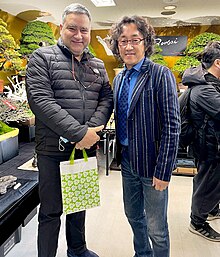Shinji Suzuki (born 1954) is a Japanese bonsai artist and master known for his traditional yet innovative approach to bonsai cultivation.

Early life and training
editShinji Suzuki was born in 1954 in Japan. His journey in bonsai began in his youth, inspired by the serene beauty of nature and the cultural tradition of bonsai in Japan. His skills were honed through a rigorous apprenticeship under the legendary bonsai master Masahiko Kimura. This period was formative in Suzuki's career, allowing him to absorb traditional bonsai techniques while also developing his unique artistic vision, characterized by an emphasis on simplicity, balance, and a deep connection to natural forms.[1][2]
Artistic philosophy
editSuzuki's bonsai philosophy centers on working harmoniously with each tree's natural form. He believes that bonsai artists should respect the inherent beauty of the tree rather than impose rigid, artificial forms. Suzuki's creations often emphasize natural branching and trunk lines, and he prioritizes allowing each tree to develop in a way that mirrors its growth in the wild. This philosophy reflects aspects of Zen and Taoist principles, particularly the idea of harmony with nature, a core tenet in traditional Japanese aesthetics.[1]
Work and notable exhibitions
editShinji Suzuki's works are featured in many bonsai exhibitions in Japan and around the world. His garden in Obuse, Nagano, is home to a significant collection of bonsai masterpieces, including ancient trees dating back to the Tokugawa period. This space is notable for its meticulous arrangement, which demonstrates Suzuki's attention to detail not only in bonsai but also in the surrounding environment. The order and cleanliness of his garden are seen as an extension of his artistry, creating a setting that enhances the bonsai viewing experience.[2]
Teaching and legacy
editSuzuki is also a teacher who has trained several apprentices from Japan and abroad, passing down traditional bonsai techniques while encouraging individual expression in the art form. His teachings emphasize patience, observation, and an understanding of each tree's unique potential, guiding students to foster a deeper appreciation for bonsai as a living art. Through his students and workshops, Suzuki has inspired a new generation of bonsai artists and contributed significantly to the international spread and appreciation of Japanese bonsai culture.[1]
References
edit- ^ a b c "Shinji Suzuki: The Art and Philosophy of a Bonsai Master – Indoor Bonsai Tree Care". indoorbonsaitreecare.com.
- ^ a b Valavanis, William N. (May 2, 2017). "A Visit To Shinji Suzuki's Bonsai Garden, Obuse, Japan". Valavanis Bonsai Blog.